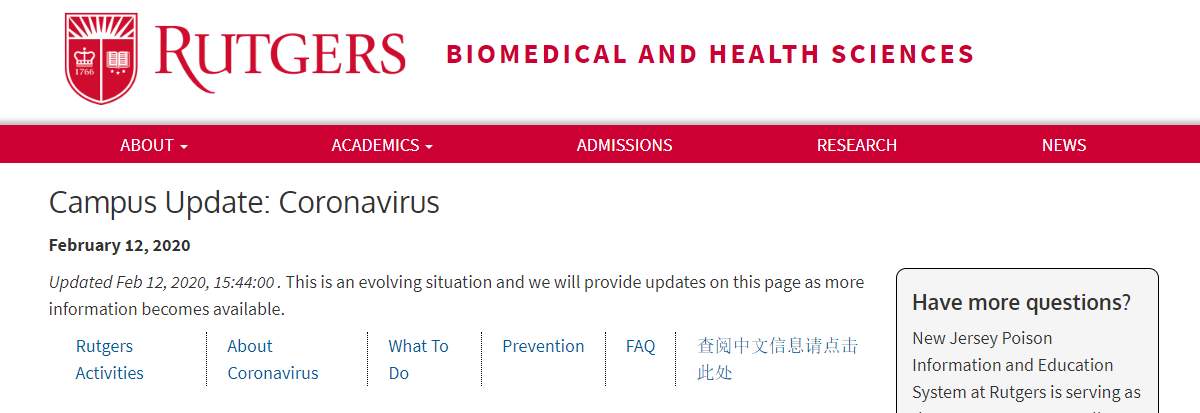

Across the U.S., universities are preparing their facilities, monitoring student populations, pre-empting study abroad programs and communicating with students, faculty and parents to prevent an outbreak of COVID-19 on campus.
From Marketwatch:
“With large groups of people sharing living spaces, classrooms, libraries and dining halls, colleges face unique challenges in managing contagious illnesses. ‘Universities are often the most global and we are often on the front lines of these situations,; said Dr. Sarah Van Orman, the associate vice provost for student health at the University of Southern California. The school has 6,626 students from China, the second-largest population of students from China in the U.S., according to the IIE….”
“USC started monitoring students who visit the university health center for symptoms of coronavirus more than three weeks ago, Van Orman said. The university, she added, ‘does not make decisions alone’ when it comes to isolation, quarantine or activating one of its emergency disease plans. ‘We are making the decisions with the local authorities and they have jurisdiction over the event.’ “
Van Orman stated in the MarketWatch article that many students who come to the health center worried they have COVID-19 end up being diagnosed with the flu, which is quite common during the winter months.
Consistent with federal advisories, Rutgers University in New Jersey is restricting all travel to China—this includes travel for university business such as (but not limited to) teaching, study abroad, conferences, presentations, internships, research, recruiting, and athletic competitions.
Princeton University, also in New Jersey, is following a New Jersey Department of Health recommendation asking faculty and students who have recently returned from China to self-quarantine if they are at moderate or high risk for contracting the illness.
Miami University in Ohio has posted online that students, faculty, or staff members who return to the U.S. from China after Sunday, Feb. 2 “will not be permitted to come to campus to work, attend class, or participate in any campus or community activity for 14 days after leaving mainland China.”
Meanwhile, Duke Kunshan University’s campus in China will be completing session 3 courses online and possibly session 4 courses the same way.
Like other universities, Duke has established a health communications hub online for its students, staff and parents. One recent link warns students about phishing emails that claim to be from the Centers for Disease Control with information about how to protect the students from the illness.
While the CDC doesn’t specifically address preventing the spread of COVID-19 in universities, the New Jersey Department of Health has released guidelines for New Jersey college campuses:
“Cleaning Procedures
“Special sanitizing processes beyond routine cleaning, including closing schools to clean every surface in the building are not necessary or recommended to slow the spread of respiratory illness. Schools should follow standard procedures for routine cleaning and disinfecting with an EPA‐registered product. Typically, this means daily sanitizing surfaces and objects that are touched often, such as desks, countertops, doorknobs, computer keyboards, hands‐on learning items, faucet handles, phones and toys. How should schools prepare for the potential of coronavirus in their community? “
- “Instruct all students, faculty and staff who have traveled to China in the past 14 days to immediately contact university health services or other contact as designated by the university.
- Students who visit health services should be instructed to wear a mask when they present with respiratory symptoms.
- Health personnel should inquire about travel history. · Clinicians should wear personal protective equipment to guard against potential exposure.
- Continue to monitor up to date information from health officials.
- School health services should continue to monitor students and staff who my exhibit respiratory symptoms. · Always promote daily practice of everyday preventive actions.
- Establish relationship with local public health officials and identify points of contact.
- Report any ill students with a travel history to the local health department immediately.
- Have supplies on hand for staff and students (masks, soap, tissues, hand sanitizers, trash baskets).
- Develop a plan for outbreak response and share with stakeholders
- Prepare to offer other alternatives for instruction of students.
- Create emergency communication plan and maintain up to date contact information for everyone in your communication chain.
- Establish leadership team, identify essential staff functions, assign tasks and responsibilities.
- Plan workshops and trainings to educate staff on prevention measures.
- Ensure students who may need to quarantine or isolate and cannot return to their home have housing and basic needs.”
For more resources visit, The Centers for Disease Control , the World Health Organization and BOMA International’s Coronavirus Guide for facilities.
